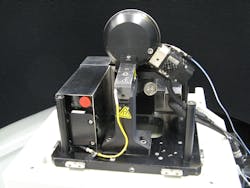OPTICAL FABRICATION: Miniature MRF machine can use novel polishing fluids, has new uses
Magnetorheological finishing (MRF) is an optical-fabrication technique whose name is synonymous with QED Technologies (Rochester, NY), and with good reason: MRF, invented in the former Soviet Union and further developed at the University of Rochester’s Center for Optics Manufacturing, was then commercialized by QED and has been extensively developed by the company ever since. In MRF, the stiffness of an abrasive-doped fluid is magnetically controllable, providing a finely tunable optical shaping and polishing process that, among other things, is ideal for fabricating precision aspheres.
A typical MRF machine is large, fitting inside an enclosure a couple of meters on a side, a size easily accommodated by a typical optics-fabrication facility. However, researchers at QED realize that there are other potential applications for MRF that could be developed in laboratories that are not well-suited for a standard MRF machine, but could use a smaller, more flexible MRF device. As a result, QED has come up with a much more compact “mini-MRF” machine that in addition has fewer limitations on the types of MR fluid that it can use (see figure). The technology was unveiled by QED at SPIE’s Optifab 2011 (Rochester, NY) in May.
“Even though MRF is now a mature and well-established technology, it can still be improved,” says Andrew Kulawiec, president of QED. “One of the areas of the MRF system that limits the types of applications is the fluid-delivery system. With the current MRF fluid-delivery systems, the MR fluid must be pumped through a number of control devices and a nozzle before being placed on the wheel in the form of a ribbon. This limits options for the chemical composition and rheological properties of the fluid, and therefore the removal rate of the polishing process. With the new MRF prototype, both of these limitations are relaxed, giving us much greater flexibility to develop fluids that are optimized for different materials and applications. The new prototype is also more modular, which will allow MRF to be used in a greater variety of machines and processes.”
Smaller fluid-delivery system
The company has demonstrated the concept on a 150-mm-diameter wheel, which is a standard wheel size for its current MRF machines. (The wheel has magnetic properties that hold the fluid on the wheel as it spins for polishing.) QED also offers MRF machines with 20, 50, 200, and 370 mm wheels, some of which can be interchanged on its machines. So the wheel itself is not what is smaller: It’s the fluid-delivery system that is significantly smaller. The primary challenge, Kulawiec notes, was to integrate into the device all components required for forming a polishing ribbon on the wheel and monitoring MR fluid properties in order to provide a stable material-removal rate. Once the basic idea was conceived, a prototype was built and tested to prove the concept.
The basic polishing process is still MRF, so the miniature device can achieve surface-figure errors in the nanometer range and surface roughness values in the Ångstrom range, depending on the material and the quality of the metrology. While it can be used for deterministic polishing, like conventional MRF for figure correction, it can also be used in uniform (or bulk) removal processes for subsurface-damage removal or aspherization. The same diamond and cerium oxide based fluids that are used in QED’s conventional MRF machines can be used with this new technology. But in addition, new fluids can be developed to provide for higher removal rates and for unique materials.
For conventional optics polishing, the potential for new fluid chemistries can allow unusual optical materials to be processed; the ability to more rapidly replace used MR fluid with fresh fluid allows higher removal rates, especially on very hard materials such as sapphire and silicon carbide. But more exciting are the possible unconventional uses. “We are still exploring the possibilities,” says Kulawiec, “but some that come to mind include rapid subsurface-damage removal on optics or semiconductor materials, edge polishing of thin glass wafers or substrates to increase surface strength, and back-thinning of wafers. Another one is the rapid removal of coatings: The chemical properties of many coatings can disrupt the chemical balance of the polishing fluid, making it difficult to continue using the fluid on other materials. Changing fluid is usually a lengthy and costly proposition. The new MRF prototype allows for fast fluid changeover and there is very little waste (low cost), so you have a lot of flexibility in the types of materials you polish as well as when, in your shop’s workflow, you polish.”
QED is considering designs that can be used with robotic arms or motion-control systems in automated environments. “We are continuing to develop and test this technology within our R&D group, and we have begun discussing a variety of potential applications with our current customers and new potential customers,” notes Kulawiec. “We expect to develop plans to commercialize this technology in some form over the next year or so.”

John Wallace | Senior Technical Editor (1998-2022)
John Wallace was with Laser Focus World for nearly 25 years, retiring in late June 2022. He obtained a bachelor's degree in mechanical engineering and physics at Rutgers University and a master's in optical engineering at the University of Rochester. Before becoming an editor, John worked as an engineer at RCA, Exxon, Eastman Kodak, and GCA Corporation.
